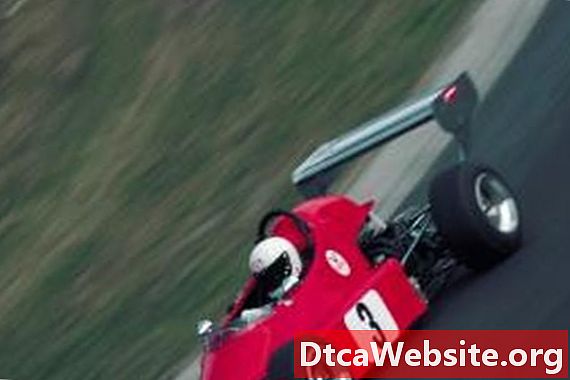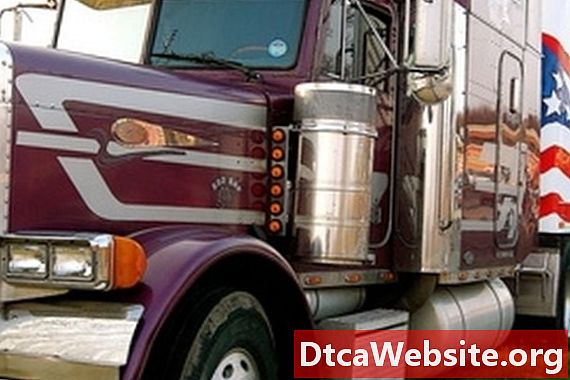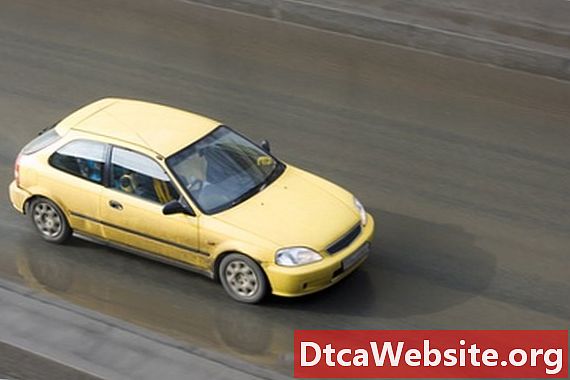
Contenu
- What is Staggering?
- Wider Rear Tires
- Wider Front Tires
- Tire Diameter and Aspect Ratio
- Practical Considerations
- The Right Size, the Right Stance

Nothing speaks more or a vehicles purpose, and the drivers priorities, than the tires it uses. A set of short-sidewall tires might tell passers-by that your car is a handler, and that nimble maneuvering is a top priority for you. Off-road tires say your life is in the weeds -- so to speak -- and a fat set of rear rollers say that youre either a straight-line speed demon or that youre putting loads of power to the ground. The practice of "tire staggering" can drastically alter both your cars performance balance and the that its looks deliver, but approach with caution. These days, theres a bit more to think about than just looking cool and going fast.
What is Staggering?
Staggering is the practice of using different-sized tires on different wheels of the car on order to compensate for the different stresses that tires on the front and rear must deal with. A Top Fuel dragster would represent one really extreme case of staggering: its tiny pizza-cutter front wheels are absolutely dwarfed by the dragsters rear slicks. The Top Fueler uses extreme front-rear staggering like this because the rears are responsible for putting every one of those 10,000 nitro-powered ponies to the track, while the fronts wheels are only there to keep the nose off the ground and steer a bit.
Wider Rear Tires
Most of the time, youll see tire staggering take the form of larger -- wider and/or taller -- rear tires. This big-rear-tire look is one that weve long come to associate with performance, and it is a necessity on some rear-drive cars. Wider rear tires mean more traction under acceleration, which is helpful when launching from a standstill, but can also be a life saver on the back roads. the best way to get through a corner is "slow in, fast out," meaning that youll slow down to make the turn, turn in, hit the apex and "power out" of the corner after the apex. Applying the power in a rear-drive car while turning will almost always break the rear tires traction and induce "oversteer" or "powersliding." While fantastic fun when intentional, and a good way to control the cars direction when used in moderation, an unwanted or unexpected powerslide is a dangerous animal. Big rear tires stabilize the back of the car, helping to keep it on track while turning. But you can definitely have too much of a good thing here; huge rear tires can create a car with terminal "understeer," meaning that it will always try to go straight instead of turn when you want it to.
Wider Front Tires
Wide rear tires look classically cool, but theyre pointless on a lot of cars on the road today; the majority of front- and all-wheel-drive cars on the road today would probably do best with wider front tires. Front-drive vehicles always understeer when coming out of a turn, because youre forcing the front tires to both turn the car and put power to the ground. Thats especially relevant when you consider that weight -- and thus traction -- shifts to the rear under acceleration, and to the front under braking. Wider front tires on a front-drive car will help it to do everything better: stop quicker, turn in sharper, hold the turn better and allow you to power out of the turn more viciously by warding off a certain amount of understeer. Theyll also pay huge dividends in acceleration. Weight shifting to the back of the car at launch unloads the front tires, reducing grip and reducing the amount of power you can put down. Wider front tires can give you just the edge you need to go from a quick start to a neck-snapping launch. All-wheel-drive vehicles, which usually act like front drivers, can benefit similarly from wider front tires, albeit a bit less so.
Tire Diameter and Aspect Ratio
Taller tires, particularly on the back, do look cool -- but most of the time, the increase in diameter is a necessary evil, and a concession to the tires aspect ratio. Aspect ratio is the height of the tire sidewall relative to its width; a higher number is a taller sidewall, and a lower number is a shorter sidewall, or "lower profile." If you increase a tires width but not its height, you wind up with shorter sidewalls relative to the width, and an effectively lower aspect ratio. This is a vital consideration, because higher aspect ratios -- taller sidewalls relative to tread width -- provide more straight-line traction, but soften the turning response. Shorter sidewalls or lower profile tires provide sharper cornering response, at the cost of straight-line traction and smooth, predictable "break away" while cornering. So, if you install wider rear tires intending to increase rear traction and stabilize the car, but dont increase diameter, youll wind up completely defeating the purpose. The lower rear aspect ratio will make the rear break away harder during cornering and lose traction faster under acceleration, making the car skittish and unpredictable while cornering.
Practical Considerations
There are a lot of practical considerations to bear in mind when deciding whether or not to go with a staggered tire arrangement. If you use different-sized tires on the front and rear, you cant rotate the tires front-to-rear, which is definitely going to cost you in the long run in terms of tire replacement. You can swap them side to side, but then you have to consider the type of tire. The best tires have directional tread grooves, angled backward to efficiently eliminate water. Directional tires can only turn in one direction, so in order to swap them side-to-side, youll have to have them removed from the rims and re-mounted every time. That wont be cheap, fast or easy. And if you use super-high-performance "asymmetrical" tires that can only be used on the left or right sides of the car, you could very well wind up with four different tires that you cant rotate at all. That is a massive pain in the real world, so avoid it at all costs. If you run taller tires, youll have to reprogram your cars antilock brake controller and drivetrain computer with the new tire size; otherwise, your antilock brakes, traction control, stability control and speedometer wont work correctly. Make sure your vehicle has the provisions to reprogram these controllers before you buy the tires. You cant use different-height tires on all- or four-wheel-drive vehicles.
The Right Size, the Right Stance
At the end of the day, tire staggering is all about changing the cars traction balance under cornering, braking and acceleration. That change in traction balance comes by way of different tire widths, so thats where youll want to start when deciding on a stagger. First, pick the width ratio that will give you the change in traction balance youre looking for. If you need a bit more traction in the back, use rear tires that are 10 to 20 percent wider than the fronts -- or use whatever percentage suits your needs. Vice-versa for the fronts. Once you have the width selected, make sure you can reprogram your cars computers to accept taller-diameter tires on the front and rear axles separately. Once youve confirmed that, you need to decide on an aspect ratio. In general, youre going to find the best performance balance, and the coolest visual "stance" by using the same aspect ratio front and rear. On a rear-drive car, that means slightly shorter, thinner tires on the front and taller, wider tires on the rear. Thatll give you a very cool "rake," or downward-pointed nose, good for both performance and show points. If you must use different aspect ratios, try to put the lower-profile tires on the non-driven wheels; that may require a larger diameter rim on the non-driven wheels if you want to maintain a certain tire height.


